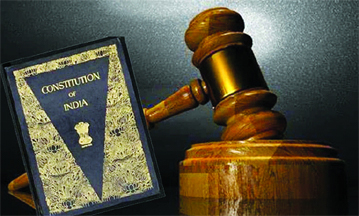
The Constitution of India, adopted on January 26, 1950, is the longest written constitution in the world. It provides the fundamental legal framework for the governance of the country, outlining the structure of government, the distribution of powers, and the fundamental rights of citizens. However, like any living document, the Constitution has been subject to changes over time through amendments. Since its adoption, the Indian Constitution has undergone numerous amendments to address emerging issues, evolving political and social landscapes, and changing legal requirements.
The Amendment Process: Article 368
The Constitution of India provides a comprehensive mechanism for its own amendment under Article 368. This article allows Parliament to amend the Constitution, subject to certain procedures. Amendments can be initiated in either house of Parliament and must be approved by a two-thirds majority of members present and voting. Some amendments require ratification by at least half of the State Legislatures, especially those affecting federal provisions or the distribution of powers between the Union and the States.
Over the years, the Constitution of India has been amended over 100 times, reflecting the dynamic nature of Indian democracy and the need for the Constitution to adapt to the changing needs of society.
Key Amendments in the Indian Constitution
The First Amendment (1951)
The First Amendment was introduced in response to several issues arising in the early years of the Republic. The amendment aimed to limit the scope of freedom of speech and expression under Article 19 by imposing restrictions on certain grounds such as public order, decency, and morality. It also provided for the reservation of seats for scheduled castes and scheduled tribes in local bodies and expanded the grounds for restricting freedom of speech.
The 42nd Amendment (1976)
Often referred to as the “mini-Constitution,” the 42nd Amendment was one of the most significant overhauls of the Indian Constitution. It was passed during the Emergency period (1975-1977) under the leadership of then-Prime Minister Indira Gandhi. The amendment made sweeping changes, including:
– Curtailment of the power of judicial review: It attempted to limit the judiciary’s power to review laws passed by Parliament.
– Introduction of the term ‘Socialist’ and ‘Secular’: The preamble was amended to include the words “Socialist” and “Secular,” reflecting the evolving political ideology.
– Strengthening the executive: The powers of the President were expanded, while the powers of the judiciary and legislature were diminished.
– Promoting Fundamental Duties: The amendment introduced Fundamental Duties under Article 51A, emphasizing the moral obligations of citizens towards the nation.
The 44th Amendment (1978)
The 44th Amendment was a direct response to the controversial 42nd Amendment. It sought to undo many of the changes made by the earlier amendment, particularly those that limited the powers of the judiciary. Key provisions included:
– Restoration of the right to property: The amendment reversed the 42nd Amendment’s provisions that had effectively removed the right to property as a fundamental right.
– Strengthening the judiciary: It ensured the independence of the judiciary and reaffirmed the principle of judicial review.
The 73rd and 74th Amendments (1992)
The 73rd Amendment (for rural areas) and the 74th Amendment (for urban areas) introduced significant changes to the Indian system of local governance. These amendments provided for the establishment of Panchayats (rural local bodies) and Municipalities (urban local bodies) at the grassroots level. They included provisions for the direct election of representatives, reservation of seats for women, scheduled castes, and scheduled tribes, and the devolution of powers to local bodies. These amendments sought to promote democratic decentralization and empower local governance institutions.
The 86th Amendment (2002)
The 86th Amendment introduced major changes related to education. It made education a fundamental right for children between the ages of 6 and 14 by amending Article 21-A. This amendment provided a legal basis for the Right to Education Act (2009), which aimed to ensure free and compulsory education for all children in this age group.
The 97th Amendment (2011)
The 97th Amendment focused on cooperative societies and their functioning. It inserted Article 43-B, which emphasizes the promotion of cooperative societies as a means of economic development. The amendment also provided for the regulation of cooperative societies through legislation at the national level.
The 101st Amendment (2016)
The 101st Amendment marked a significant reform in India’s tax system with the introduction of the Goods and Services Tax (GST). The amendment laid the foundation for the implementation of GST, which replaced various indirect taxes levied by the Union and the States, providing a unified tax structure across the country. This reform aimed to simplify the tax system, increase tax compliance, and boost economic growth.
The 103rd Amendment (2019)
The 103rd Amendment introduced a provision for economically weaker sections (EWS) of society, allowing them to access 10% reservation in educational institutions and government jobs. This amendment was seen as an effort to provide greater opportunities for disadvantaged groups, particularly those who did not fall under the existing reservation categories based on caste.
The 104th Amendment (2020)
The 104th Constitutional Amendment Act of 2020 extends SCs/STs seat reservations in the Lok Sabha and State Assemblies until 2030 while abolishing the Anglo-Indian reserved seats. It also amends Article 334 to reflect these changes.
The 105th Amendment (2021)
The 105th Amendment of India, also known as the Constitution (One Hundred and Fifth Amendment) Act, 2021, restored the power of state governments to identify socially and educationally backward classes (SEBCs). The amendment came into effect on August 18, 2021.
The 106th Amendment (2023)
The 106th Amendment Act of 2023 was the most recent amendment to the Constitution of India. It reserved one-third of all seats in the Lok Sabha, State Legislative Assemblies, and the Legislative Assembly of Delhi for women.





2022 Gujarat floods government relief efforts